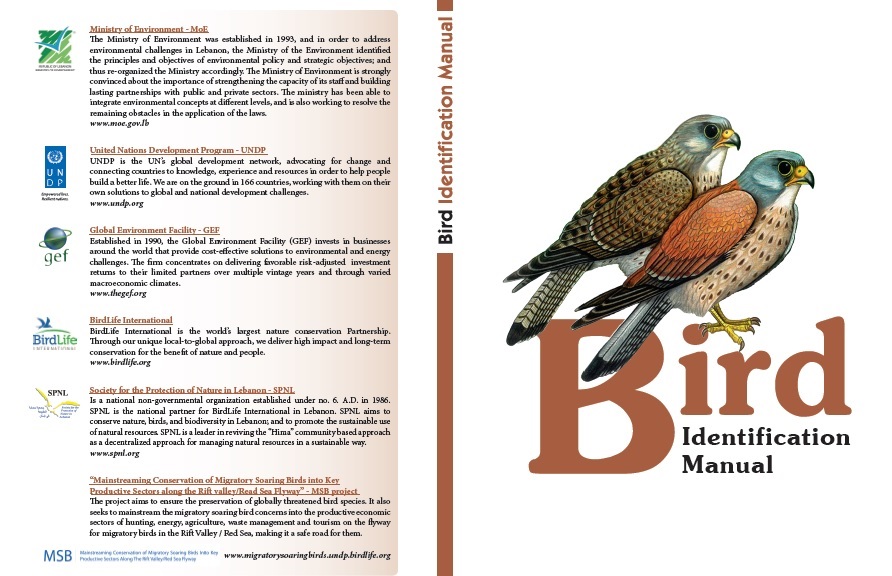
Bird Identification Manual
[button color=”green” size=”medium” link=”http://www.spnl.org/wp-content/uploads/2014/12/Bird-Identification-Manual-Low.pdf” target=”blank” ]Download the Book[/button]
Plant pollinators, seed dispersers, agricultural pest controllers, environmental health indicators, amusers, art and technology inspirers… They are the birds, the ecological agents that perform valuable services!
Identifying birds is a fascinating, ever-changing activity that increases our awareness and appreciation of natural wildlife.
Further, the birds represent an amazing group of species, and they act in different roles in different habitats, and are a delight to the senses with such variations in color, song, and incredible differences in flight pattern. Their sheer variety and elusive nature give the serious bird watcher an opportunity to pursue his passion with infinite challenge and high level of success. This growing awareness of bird identification, however, comes at an odd time; migratory soaring birds are in jeopardy.
Their decline is attributed primarily to human short-sighted practices such as illegal shooting of birds, the destruction of habitats needed by the resident and migratory soaring birds over use of agrochemicals, pollution, etc…. Although there is a certain irony in people becoming enthusiastic about migratory soaring birds as they disappear, it also presents an opportunity: bird watchers may be the economic and political force that can help save the birds. How much bird watchers spend on bird identification is no joke, and the economic values presented by bird identification can be used by resource managers and policy makers to demonstrate the economic might of bird watching, the value of bird identification and by extension, the value of birds.
Experiencing bird identification according to this manual can offer enormous benefits on an individual level as well as providing the opportunity to understand the pressures facing birds and bird habitats, and help contribute to conservation. Rest assured that there’s a lot to learn!
Executive Summary
This “Bird identification Manual” provides the guidelines needed for the differentiation between bird species!
The book is divided into 9 main chapters, as follows:
Section One: Learn the Basic Bird Body Parts
Section Two: Arm Yourself with Bird Watching Tools
Section Three: Observe the Bird Identification Criteria
Section Four: Join Migratory Birds on their Journeys…
Section Five: Discover Bird Groupings and Families
Section Six: Game or Non-game Bird Species?
Section Seven: Threatened Birds Alert!
Section Eight: Importance of Bird Conservation
Section Nine: Get Ready, it’s Field Time!
The first three sections provide an overview of bird body parts, guidelines for bird identification criteria, and the tools used in bird watching. Section four explains the miracle of migration, strategies used, threats, and survival. Section five presents the bird families identified in Lebanon. Section six is dedicated for detailed information on game species, while section seven is for globally threatened species. Section eight concentrates on the importance of bird conservation through awareness, education,
and direct action. Section nine provides guidelines for bird watching: before the trip, during bird watching in the field, and after coming from the field.
This “Bird identification Manual” is an important educational resource for trainings and capacity building on birds, migration, and skills for bird identification!
Acknowledgment
This “Bird identification Manual” is an achievement for birds and biodiversity in Lebanon. It would be an important resource for trainings and capacity building on birds, migration, and skills for bird identification.
For this achievement, many thanks are extended to Mr. Edgard Chehab, Ms. Jihan Seoud, Mrs. Joelle Salameh, and Mrs. Yendi Ghossein from the Energy and Environment Programme – UNDP for their support and cooperation. Further gratitude goes to the team of the MSB Regional Flyway Facility for their technical review of the manual. Special appreciation is directed to Dr. Saleem Hamadeh – MSB project manager in Lebanon and his team for the support they provided to the Society for the
Protection of Nature in Lebanon-SPNL and their cooperation towards the production of this book.
Further thanks goes to Ms. Lara Samaha – Head of the Ecosystems Department at the Ministry of Environment for her follow-up, cooperation and support. Sincere gratitude is directed to the Global Environment Facility that provided the opportunity and funds for the Development and production of this important resource for Lebanon, through the Project – Mainstreaming Conservation of Migratory Soaring Birds into Key Production Sectors along the Rift Valley/Red Sea Flyway.
It is also important to acknowledge the technical support provided from Dr. Ghassan Ramadan-Jaradi, Ornithologist, for the scientific update, and bird pictures; the artist Husein Ali Zorkot for the bird illustration used in the cover pages of this manual, the artist Karen Wade for her illustrations; in addition to Andre Bchara and Adonis Khatib for their pictures. Special appreciation and thanks for artist contributions towards the production of the “Bird identification Manual”, namely: A. Bearch, G. Gill, M. Langman, and B. Small.